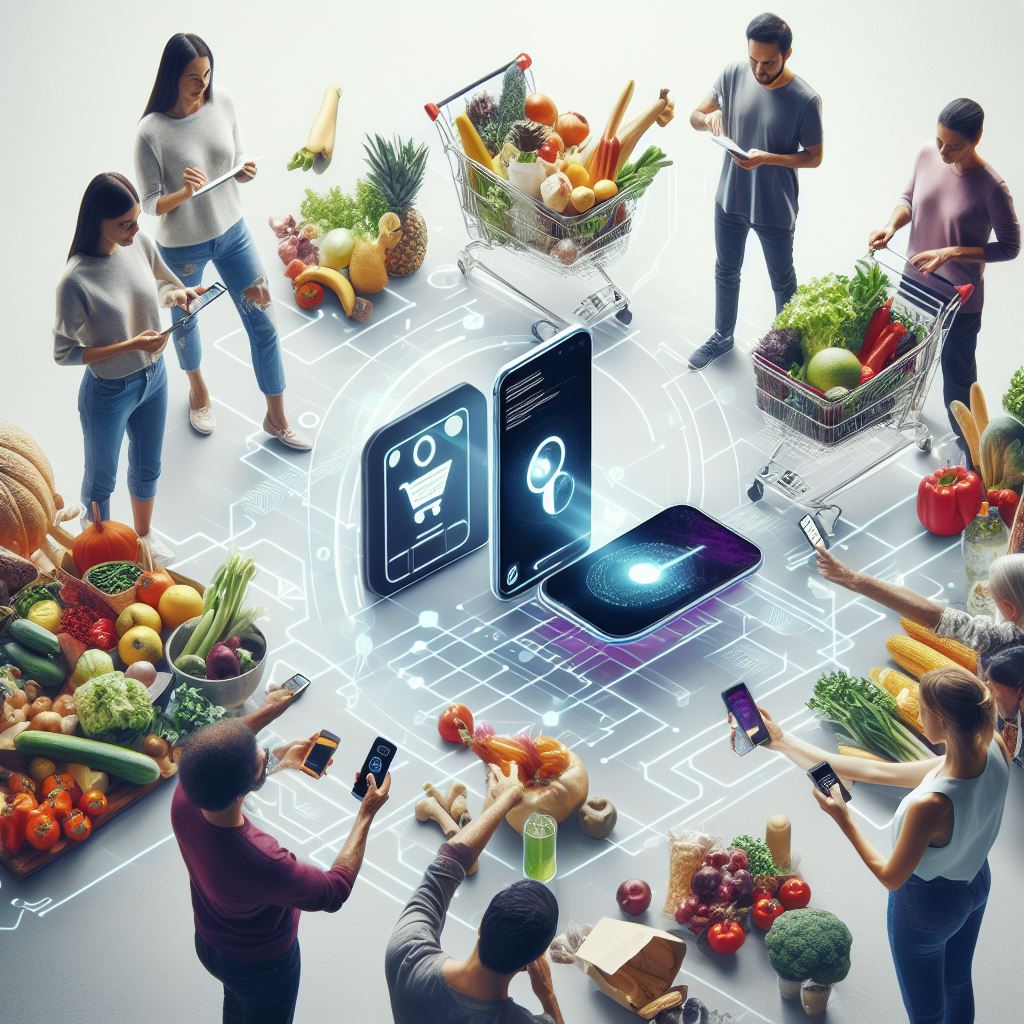How Technology Is Revolutionizing Food Stamps

Imagine a world where applying for food stamps is as easy as a few clicks on your smartphone. Thanks to technology, that world is now a reality.
Online applications have simplified the process, while Electronic Benefit Transfer (EBT) cards have improved convenience.
Mobile apps have made food stamps more accessible than ever before.
With data analytics driving efficiency, technology is reducing stigma and promoting dignity for those in need.
This article explores how technology is revolutionizing the way we distribute and utilize food stamps.
Key Takeaways
- Online applications and digital submissions significantly reduce application time and errors
- Electronic Benefit Transfer (EBT) cards offer a seamless and user-friendly experience, eliminating the need for physical vouchers or coupons
- Mobile apps provide increased accessibility for food stamp users, allowing them to conveniently access their benefits anytime and anywhere
- Technology, such as mobile apps and data analytics, reduces stigma and promotes dignity for food stamp recipients while enhancing the efficiency and effectiveness of food stamp programs.
Online Applications Simplify the Process
Simplify your application process by utilizing online applications for food stamps. In today’s digital age, applying for food stamps has become more accessible and efficient thanks to the power of technology. Online applications provide a streamlined and user-friendly experience, allowing individuals to apply for assistance from the comfort of their own homes.
According to recent data, online applications for food stamps have significantly reduced the time it takes to complete the application process. On average, applicants spend less than 30 minutes filling out the online form, compared to the hours it used to take when applying in person or through paper applications. This time-saving feature is particularly beneficial for individuals who may have limited access to transportation or face mobility challenges.
Moreover, online applications also help reduce errors and inaccuracies in the application process. The online platform provides built-in validation checks and prompts, ensuring that all required fields are completed correctly. This not only saves time for both applicants and caseworkers but also improves the accuracy of the information provided.
In addition to simplifying the application process, online applications also expedite the processing time. Digital submissions are automatically sent to the appropriate agency, eliminating the need for manual data entry and reducing the risk of lost paperwork. This efficient workflow allows for faster processing and ultimately enables eligible individuals to receive food stamps in a timelier manner.
Electronic Benefit Transfer (EBT) Cards Improve Convenience
To further enhance the accessibility and convenience of applying for food stamps, Electronic Benefit Transfer (EBT) cards offer a seamless and user-friendly experience. EBT cards have revolutionized the way food stamp benefits are distributed, eliminating the need for physical vouchers or coupons. With an EBT card, recipients can simply swipe their card at authorized retailers to pay for eligible food items. This eliminates the need for paper-based processes, reducing administrative costs and streamlining the distribution of benefits.
EBT cards also offer a significant advantage in terms of convenience. Recipients no longer have to carry large amounts of cash or worry about losing or misplacing vouchers. The cards offer a secure and easy-to-use method of accessing benefits, ensuring that individuals and families can purchase food items without any hassle.
Furthermore, EBT cards provide recipients with greater flexibility in terms of where they can shop. These cards are accepted at a wide range of retailers, including grocery stores, supermarkets, and even farmer’s markets. This allows individuals to choose the most convenient location to purchase their groceries, providing them with more options and reducing barriers to accessing nutritious food.
With the convenience and flexibility that EBT cards provide, it’s no wonder that they’ve become the preferred method of distributing food stamp benefits. However, technology continues to advance, and mobile apps are now further enhancing accessibility for food stamp users.
Mobile Apps Enhance Accessibility for Food Stamp Users
With the convenience and flexibility offered by EBT cards, you can now further enhance your access to food stamp benefits through mobile apps. These apps are revolutionizing the way food stamp users manage their benefits, making it easier and more convenient for them to access and utilize the assistance they need.
One of the key advantages of using mobile apps for food stamp benefits is the increased accessibility they provide. According to a study conducted by the USDA, over 80% of Americans own a smartphone, making it a widely accessible platform for delivering essential services like food assistance. By utilizing mobile apps, food stamp users can conveniently access their benefits anytime and anywhere, eliminating the need to visit physical offices or wait in long lines.
These apps offer a range of features that enhance accessibility and streamline the process of accessing food stamp benefits. Users can easily check their balance, view transaction history, and even receive notifications about upcoming benefit renewals or changes in their eligibility status. Additionally, some apps provide access to resources like recipes, nutrition information, and tips for budgeting and shopping wisely.
Furthermore, mobile apps ensure privacy and security for food stamp users. By allowing users to access their benefits through their personal devices, these apps eliminate the need for physical cards that can be lost or stolen. This not only safeguards the user’s personal information but also provides peace of mind knowing that their benefits are secure.
Technology Reduces Stigma and Promotes Dignity
Mobile apps for food stamp benefits not only enhance accessibility, but they also contribute to reducing the stigma associated with receiving assistance and promote dignity for users. These technological advancements have revolutionized the way food stamps are distributed and utilized, positively impacting the lives of millions of individuals and families.
- Mobile apps allow for discreet transactions: Gone are the days of standing in long lines at the grocery store, visibly handing over food stamps. With mobile apps, users can discreetly make their purchases without drawing attention to their financial situation.
- Increased convenience and autonomy: By having access to their benefits through mobile apps, individuals can conveniently manage their food stamp accounts. This empowers them to make their own choices about what they need and when they need it, enhancing their sense of autonomy.
- Reduction in judgment and discrimination: The use of mobile apps reduces the chances of judgment and discrimination that food stamp recipients may face. With transactions occurring electronically, there’s no physical evidence of receiving assistance, minimizing the potential for stigmatization.
According to a study conducted by the United States Department of Agriculture, 90% of food stamp participants reported feeling a reduction in stigma and an increased sense of dignity when using mobile apps for their benefits. This data highlights the powerful impact that technology can have on improving the overall experience for food stamp users.
Through the reduction of stigma and the promotion of dignity, these advancements are transforming the way individuals access and utilize food assistance programs, ultimately leading to a more inclusive and supportive society.
Data Analytics Drive Efficiency in Food Stamp Programs
By utilizing advanced data analytics, you can significantly enhance the efficiency of food stamp programs. Data analytics involves the use of powerful algorithms and statistical techniques to analyze large amounts of data and extract valuable insights. When applied to food stamp programs, data analytics can help identify patterns, trends, and areas for improvement, leading to better decision-making and resource allocation.
To illustrate the impact of data analytics in food stamp programs, consider the following table:
| Area of Focus | Data Analytics Benefit | Example |
|---|---|---|
| Eligibility Determination | Identify potential fraud and error cases, reducing improper payments | By analyzing income and asset data, data analytics can flag discrepancies and verify eligibility more accurately |
| Program Outreach | Target outreach efforts to eligible individuals, increasing program participation | Data analytics can analyze demographic and geographic data to identify underserved communities and tailor outreach strategies |
| Program Evaluation | Measure program effectiveness and identify areas for improvement | By analyzing program usage data, data analytics can assess the impact of policy changes and identify opportunities for program enhancements |
As seen in the table, data analytics can drive efficiency in food stamp programs by improving eligibility determination, enhancing program outreach, and facilitating program evaluation. By harnessing the power of data, food stamp programs can better serve their beneficiaries and optimize the use of resources.
Frequently Asked Questions
How Do Online Applications Simplify the Process of Applying for Food Stamps?
Online applications simplify the process of applying for food stamps by streamlining the paperwork, reducing wait times, and providing instant access to eligibility determinations. This improves efficiency, ensures accuracy, and helps those in need receive assistance more quickly.
What Are the Benefits of Using Electronic Benefit Transfer (Ebt) Cards for Food Stamp Users?
Using EBT cards for food stamps offers several benefits. You can easily access your benefits electronically, making it more convenient to purchase food. Plus, it reduces the stigma associated with using physical food stamps.
How Do Mobile Apps Enhance Accessibility for Food Stamp Users?
Mobile apps enhance accessibility for food stamp users by providing a user-friendly platform to manage benefits, locate participating stores, and check account balances. This technology empowers users to conveniently access and utilize their benefits anytime, anywhere.
In What Ways Does Technology Reduce the Stigma Associated With Using Food Stamps and Promote Dignity for Recipients?
Technology reduces stigma and promotes dignity for food stamp recipients. Mobile apps allow discreet access to benefits, eliminating public scrutiny. Online purchasing options mimic regular shopping experiences, increasing privacy and reducing judgment.
How Do Data Analytics Drive Efficiency in Food Stamp Programs and What Specific Improvements Have Been Made as a Result?
Data analytics drive efficiency in food stamp programs, resulting in specific improvements. With technology, agencies can identify fraudulent activity, streamline application processes, and ensure accurate benefit distribution.



